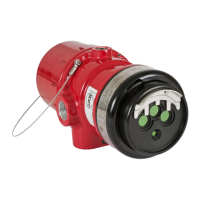Instructions, AutroFlame X33AF, 116-P-X33AF/IGB, rev. E, 2013-08-13, P/N 95-8625-17.1, Rev: 2/13
Autronica Fire and Security AS
Page 3
CAUTION
These tests require disabling of all extinguishing
devices to avoid release resulting from a
successful test.
The Mag
o
i
test is performed by placing a magnet by
the marked location (Mag
o
i
) on the outside of the
detector (see Figure 2). The Man
o
i
test is accomplished
by connecting the
o
i
lead (terminal 22) to power supply
minus via an external switch. The magnet or switch must be
held in place for a minimum of 6 seconds to complete the
test. Either of these test methods activates the calibrated
IR emitters. If the resulting signal meets the test criteria,
indicating that greater than half of the detection range
remains, the Alarm output changes state, the indicating
LED changes to red, and the 0-20 mA current output
goes to 20 mA. This condition remains until the magnet is
removed or the switch is released, regardless of whether
the relays are set for latching or non-latching operation.
If less than half of the detection range remains, no alarm
is produced and a fault is generated. The fault indication
can be reset by momentarily applying the Mag or Man
o
i
switch.
NOTE
Refer to Appendix A for FM verification of the
Optical Integrity
o
i
function.
COMMUNICATION
The X33AF is furnished with an RS-485 interface for
communicating status and other information with external
devices. The RS-485 supports MODBUS protocol, with
the detector congured as a slave device.
For HART communication, connect a HART communicator
across a 250 ohm resistor in the 0-20 mA loop.
DATA LOGGING
Data logging capability is also provided. Status conditions
such as normal, power down, general and
o
i
faults, pre-
alarm, re alarm, time and temperature are recorded.
Each event is time and date stamped, along with the
temperature and input voltage. Event data is stored in
non-volatile memory when the event becomes active, and
again when the status changes. Data is accessible using
the RS-485 port.
INTEGRAL WIRING COMPARTMENT
All external wiring to the device is connected within the
integral junction box. The screw terminals accept wiring
from 14 to 24 AWG. The detector is furnished with four
conduit entries, with either 3/4 inch NPT or M25 threads.
DETECTOR SENSITIVITY LEVELS
There are four factory congured sensitivity levels
available for the X33AF Flame Detector:
Very High, Medium, Low and T-Low.
The following criteria should be considered when
choosing a sensitivity level for the intended application:
• Detector placement
• Speed of response based on fuel type and re size
(see Appendix A for response times)
• Distance between the hazard and the ame
detector
Recommended sensitivity guidelines are as follows:
Very High: Offshore, Warehousing
Medium: General Duty, Compressors
Low: Offshore, close proximity/high IR
backgrounds
T-Low: Turbine enclosures
Additional information on X33AF Flame Detector
performance results and sensitivities can be found in
Appendix A, the FM Approval and Performance Report.
Consult the factory with any questions on how to choose
the optimum sensitivity level for the intended application.

